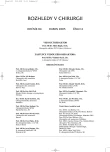-
Medical journals
- Career
Prevention, Diagnosis and Treatment of Iatrogennic Lesions of Biliary Tract during Laparoscopic Cholecystectomy. Managament of Papila Injury after Invasive Endoscopy. Part 1.
Authors: J. Šváb; M. Pešková; Z. Krška; R. Gürlich; M. Kasalický
Authors‘ workplace: I. chirurgická klinika 1. LF UK a VFN v Praze, přednosta doc. MUDr. J. Šváb, CSc.
Published in: Rozhl. Chir., 2005, roč. 84, č. 4, s. 176-181.
Category: Monothematic special - Original
Overview
Introduction:
Endoscopic invasive procedures in 70th and 80th years leaded to decrease reoperations on biliary tree. Iatrogenic injury of the biliary tract have increased in incidence in the first decade with the introduction of laparoscopic cholecystectomy. Athough a number of factors have been identified with a high risk of injury ( and number of technical steps have been emphasized to avoid these injury, the incidence of the bile duct injury has reached at least double the rate observed with open cholecystectomy. Cholecystectomy is most frequently performed abdominal operation and the most serious complication associated with this procedure is accidental injury to the common bile duct (0,3–0,4 %). This preventable technical error has tradicionally been thought to occur in one or more of three situations:
1. When the operator attempts to clip or ligate a bleeding cystic artery and also clips the common hepatic duct (Fig. 3a). 2. When too much traction has been exerted on the gallbladder so that the common bile duct has tented up into an albow, which was either tied off with ligature or clipped (Fig. 3b).
3.When anatomic anomalies were not recognized and the wrong structure is divided, for example, when the cystic duct winds anterior to the common bile duct and enters on the left side, or when the cystic duct joins the right hepatic duct rather than the junction of the common hepatic and the common bile ducts (Fig. 1, 2, 3cd).
In anatomical incertain cases is discussed about cholangiography and cholecystocholangiography during laparoscopy cholecystectomy. Most patients sustained a bile duct injury are recognized in the weeks folloving laparoscopic cholecystectomy. Careful preoperative preparation should include control of sepsis by draining any bile collections or fistulas and komplete cholangiography. Long term results are best achieved in specialized hepatobiliary centres performing biliary reconstruction with a Roux-Y hepaticojejunostomy. Success rates over 90% have been reported from several centres to date with intermediate follow-up. Papila injury increased with introduction of a invasive endoscopy. Risk of deadly retroperitoneal inflamation is very high. Injury require same surgery procedure as duodenum injury.Own experiences:
In an article a review of experiences of the Ist surgery department of General hospital in Prague since 1971 in 1 017 reoperations on biliary tree was carried out. There was in 311 patients 164 hepato-hepatostomies and 147 hepaticojejunostomies used (Tab. 1). By laparoscopic injuries were high hilar injuries (Bismuth IV) in last decade and hepaticojejunostomy was done in all cases. Died 6%, long term results are acceptable by injured patients with hepaticohepaticostomies in 70%, by hepaticojejunostomies in 90%. Reoperated were 10 % patients (Tab. 1). Remnant patients were dilated endoscopicaly. Postoperatively morbidity was high, above 26%. In years 1995–2003 were 8 patients with papila injury and inflamation in retroperitoneum operated as a injured duodenum (Tab. 2).Conclusions:
Better experiences with treatment of injured biliary tree and papila are in centres interested in hepatobilliary surgery which knowledge anatomy of hilus of liver and can make wide hepaticojejunostomy. Transfer of drained injured patient to centre is possible.Key words:
laparoscopic cholecystectomy – iatrogenic lesions biliary common duct – prevention of biliary tree injury – bile duct injury – papila Vateri injury – bile duct stenosis
Labels
Surgery Orthopaedics Trauma surgery
Article was published inPerspectives in Surgery

2005 Issue 4-
All articles in this issue
- The Radial Artery in the Myocardial Revascularization. Analysis of the Patient Subjects
- Therapeutically Options for Primary and Secondary Hepatic Malignancies
- Prevention, Diagnosis and Treatment of Iatrogennic Lesions of Biliary Tract during Laparoscopic Cholecystectomy. Managament of Papila Injury after Invasive Endoscopy. Part 1.
- Surgical Therapy of Iatrogenic Injury of Biliary Tract after Cholecystectomy and Invasive Endoscopy. Part 2.
- Laparoscopy-assisted Colonoscopic Polypectomias
- Cooperation between a Surgeon and a Gastroenterologist in the Management of Vascular Complications of the Liver Cirrhosis
- Carcinoids of the Appendix
- Options for Combining Surgical and Endovascular Techniques in the Management of Large Aneurysms and Dissections of the Thoracic Aorta
- Perspectives in Surgery
- Journal archive
- Current issue
- Online only
- About the journal
Most read in this issue- Carcinoids of the Appendix
- Prevention, Diagnosis and Treatment of Iatrogennic Lesions of Biliary Tract during Laparoscopic Cholecystectomy. Managament of Papila Injury after Invasive Endoscopy. Part 1.
- Cooperation between a Surgeon and a Gastroenterologist in the Management of Vascular Complications of the Liver Cirrhosis
- Surgical Therapy of Iatrogenic Injury of Biliary Tract after Cholecystectomy and Invasive Endoscopy. Part 2.
Login#ADS_BOTTOM_SCRIPTS#Forgotten passwordEnter the email address that you registered with. We will send you instructions on how to set a new password.
- Career

